#Turbellaria
Explore tagged Tumblr posts
Text

Day 8 of Invertober: Hammerhead worm!
Going to post the Day 6 + 7 catch-up pics later since I’m still working on it.
[Image description: A drawing of a hammerhead worm, a worm with a wide half-circle head. Most of its body is bright orange with a black-edged white stripe on the back, and its head is black with a white half-circle on the top.
Text above: Hammerhead worm
Text below: Platyhelminthes • Turbellaria • Tricladida • Bipaliinae • Bipalium choristosperma
End ID.]
9 notes
·
View notes
Note
for that ask game: your opinion on worms? any kind is fine
OH MAN. worms are one of my special interests (hence the worm themed usernames on my blogs lol) and i have A Lot to say. worm rambling below the cut. ive included some images, so if anyone here is grossed out by worms i would recommend not clicking the keep reading button
OK SO. i love all worms but my specific interest is in flatworms (platyhelminthes) so im going to talk abt them here! im especially into terrestrial flatworms (geoplanidae) but marine flatworms and smaller planarians are also very cool!
one of my favourite things abt flatworms is the variation among them. obv there's a lot of difference at higher taxonomic levels, for example you get
polycladida, the numerous and varied marine flatworms that are free swimming and often have two short tentacles on their heads, and many small ocelli! they are quite large compared to other flatworms in general too!
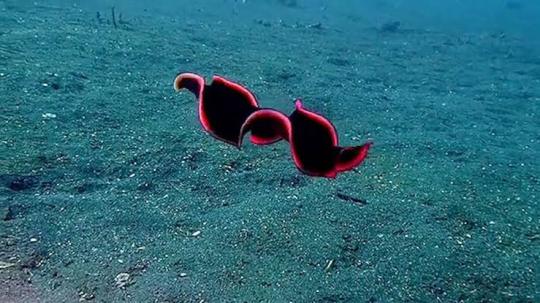
freshwater triclads, which are small and brown and live in freshwater, and usually (although not always) have two eyes!

and geoplanidae, the terrestrial flatworms, who inhabit gardens everywhere and usually (although, once again, not always) have many small ocelli!

there are more taxonomic classifications, and this isn't rlly a particularly scientific or accurate way to define them, but it's how i tend to split them up in my head lol.
geoplanidae are my favourites bc they're very easy to find where i live, and they're very beautiful and there's so much variation within the family. all of them are carnivorous, and although they will scavenge, they're often active predators and hunt other worms and also gastropods. their many ocelli (eyes) are usually pretty small and they can't see much at all, with the exception of species like the new guinea flatworm (platydemus manokwari), which is invasive in the US and has two large-ish prominent eyes on either side of its snout, and has better visual acuity than most flatworms iirc.

(see its beady wee eyes!!)
the majority of geoplanidae use chemical senses to track down their prey! because snails/slugs and other worms leave trails of slime, which are often imbued with pheromones to attract mates etc, predatory flatworms can track down their prey by following the chemicals in these trails.
once they've found their prey, they will wrap themselves around it and excrete a mucus which they use to slow down their prey. they're very strong as well so will often overpower prey using physical force! after this, they use their eversible pharynx (a kind of muscular tube) to penetrate or grasp their prey. the pharynx produces digestive chemicals through special glands. the prey is effectively digested externally, after which the flatworm will eat it.
it's a little bit horrific, but also very cool imo. flatworms can have mixed impacts on their environments, in native areas they can help control pests and keep the soil healthy, but if they become invasive they can decimate native worms and snails/slugs, which can decrease soil health. it really depends on if they're native or not.
terrestrial flatworms come in a wide variety of shapes and sizes! many of them are pretty small and long with some kind of a stripe going down the middle, as you can see in this personal photo of mine of a newzealandia graffi flatworm:
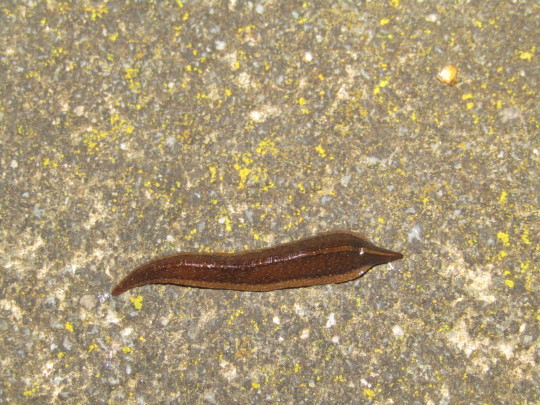
although there are many brownish flatworms, there are many others that come in lots of different colours, like this creamy-orangey one in another photo of mine (australoplana sp.):

or the blue garden flatworm (not my photo, caenoplana coerulea):

or even beautifully patterned ones like this unidentified flatworm!
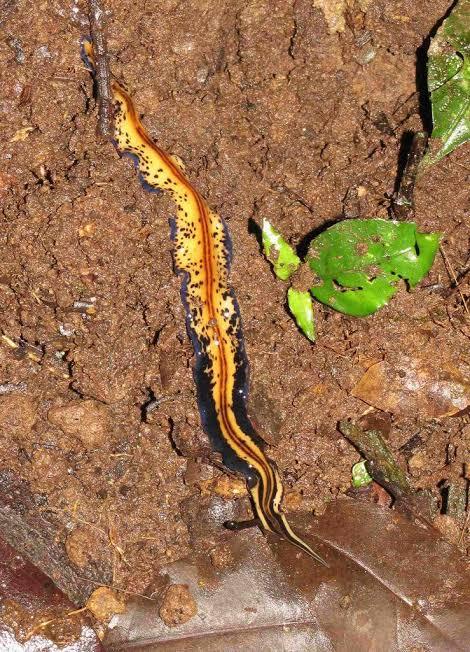
within geoplanidae, there are also hammerhead flatworms (subfamily bipaliinae), named so because of their hammer-shaped head, usually lined with ocelli around the edges:

this species is bipalium choristosperma, and is native to borneo iirc! some other species of hammerhead flatworm, i.e. the brownish bipalium kewense (im running out of pics for this post rip so no image for this one but you can google it if you're curious!) are invasive in certain areas of the united states.
other geoplanarians are invasive in some areas, like the aforementioned platydemus manokwari which is also invasive in the US, or the new zealand flatworm (arthurdendyus triangulatus), which is invasive in the UK (despite it being called the new zealand flatworm, i have yet to actually see one irl and i live in its native, non-invasive range lmao 🤷♂️). like many other invasive animals, they're very good at getting into places undetected (esp plants/soil being transported, which is how they usually make it into new countries), and are just very efficient little predators. which is unfortunately bad news for gastropods and other worms lol
geoplanarians can also get quite large! check out this Obama eudoximariae specimen (not named after the president lol)
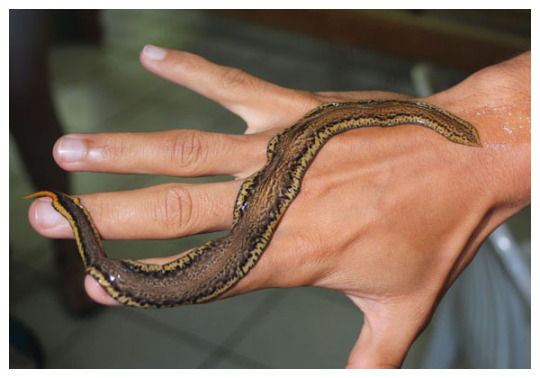
however most are usually a lot smaller than this. the flatworms where i live are usually no longer or wider than my pinky finger.
another cool fact abt flatworms is that many species can survive being cut in half, in fact each half will go on to form a new flatworm! some species will intentionally split themselves in half, or reproduce through "budding" where another flatworm just starts growing on them and eventually splits off. this is all asexual reproduction, but as well as asexual reproduction many species also reproduce sexually and lay eggs. they're such cool little beasts and have so many tricks up their nonexistent sleeves!
many species also glow in the dark under uv light. ive run out of images to add but it's cool as hell, my profile pic on my creature side blog is a photo i took of one of a newzealandia graffi worm glowing under uv light/blacklight. very cool of them to do that
ANYWAYS this post is getting long as hell and i have other stuff to do today so im gonna cut it short here. i hope you enjoyed my worm ramble :-) for anyone who is curious, i post more abt flatworms and other animals i like on my side blog @geoplanidae :-) <3 🪱
9 notes
·
View notes
Text
🪱TAPEWORMS🪱
This is gonna be a post about tapeworms, as requested by @cryptidwithacopiccollection and @budgetairlines
Tapeworms (Cestoda) are a type of endoparasitic flatworm (Platyhelminthes). Flatworms are a fun phylum of worms that are mostly parasitic with the exception of the class Turbellaria, which can be free living. Sadly this post is not about them, but have a nice picture of a Polyclad flatworm anyway :)
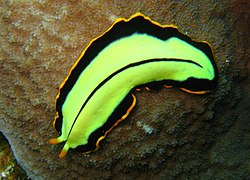
Flatworms in general lack a circulatory and respiratory system, and so have to do all their gas exchange via diffusion through their skin. This is why they have to increase their body's surface area in relation to their body's volume, as shown in this expertly drawn diagram:
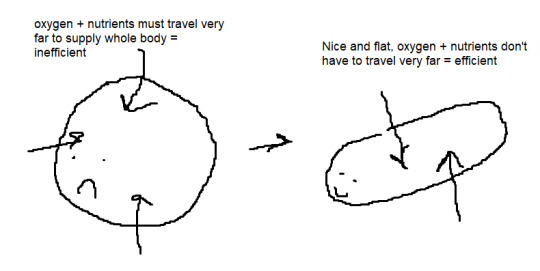
Tapeworms achieve a high surface area to body volume ratio by being really long and thin. Surface area is especially important to them, as unlike some other flatworms, they actually lack a digestive system! They just do all eating and excretion through their skin via diffusion. Being an endoparasite (a parasite that lives inside its host), they can afford to be lazy and let their host do all the hard work.

The family of tapeworms this post will be focusing on is Taeniidae. They have a very simple body plan consisting of a head (called a scolex), a neck (no fancy name), and a long segmented body (called a strobila). I've seen varying reports on how long they can get, but 15-30 feet seems like the typical size, which is horrifying. The segments that make up the strobila are called proglottids and each one contains a male and female reproductive tract, so can produce both sperm and eggs. Proglottids are generated from the neck and get pushed along the strobila where they mature and eventually shed into the host's intestines, which then get excreted into the environment. A single tapeworm can produce thousands of these things, increasing their chances at infecting another host.

Basically, a tapeworm's life inside the intestine consists of holding onto the host's gut wall with its scolex and just hanging out there, absorbing nutrients from the host's digested meals. The method of attachment depends on the specific species, but it typically involves hooks and/or suction cups.
Like many parasites, their life cycle is complex and involves more than one host. In parasitology, a 'definitive host' refers to the host the parasite sexually matures and reproduces in, whereas an 'intermediate host' is any host an immature parasite infects along the way. To explain a tapeworm lifecycle, I will be using Taenia saginata as an example, which is a tapeworm that infects humans and cattle (Bare in mind that the definitive and intermediate hosts can vary depending on species). I will be naming this T. saginata Grungus and following its journey.
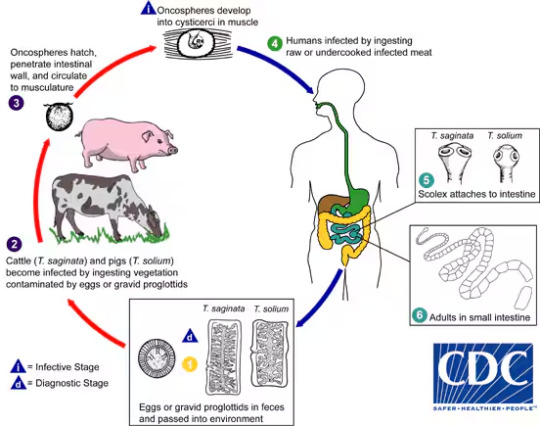
Grungus started life as an egg in the grass where it got eaten by a cow (the intermediate host). If needed, it could have survived outside for months or even years! Once inside the cow, the little embryo grungus felt comortable and hatched. It is currently in its larval form, known as an oncosphere. Grungus burrowed into the cow's intestinal walls and found a nice patch of muscle tissue to settle down in. It then developed into a cysticerci, sometimes refered to as a bladderworm due to its bladder-like shape. These appear as cysts in the muscle.
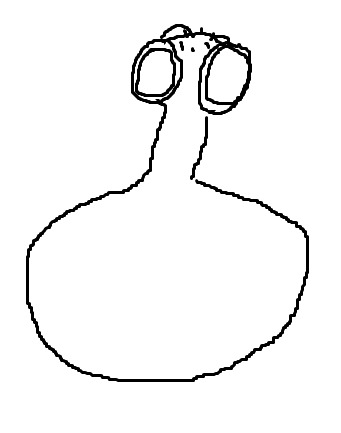
The cow got slaughtered for meat, which is unfortunate for the cow but very fortunate for Grungus. The human liked their steak rare, and so did not properly cook the meat before eating it, meaning Grungus survived and successfully made it into its definitive host. Here it was able to mature into a tapeworm, where it spent its days clinging to the intestinal wall and absorbing nutrients until it was sexually mature. It may meet another sexy tapeworm in the same intestines and mix some genetic material with it, or it may fertilise its own eggs if there's no hot singles in its area. Grungus could live to be up to 30 years old and during its life it will release many thousands of proglottids into the environment, allowing this beautiful cycle to continue <3
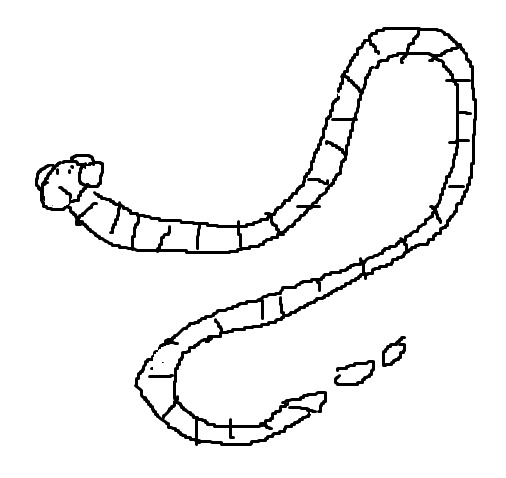
Usually, tapeworms in the intestines cause mild symptoms including stomach aches, weight loss and diarrhea, but these symptoms can vary and depend on the speices. Thankfully, they can be dealt with by taking anti-parasitic medication.
In rare cases, humans can eat the eggs of pork tapeworms and get infected by the larval form which burrow into the tissues and form a cysticerci instead of staying in the intestine. This can be very severe depending on where the cysticerci infection is located. For example, if they infect the central nervous system they cause neurocysticercosis which can be fatal in the most severe cases. Thankfully, this is rare and preventable by practicing good hygiene and cooking your pork properly, so don't panic.
Hope this was interesting to you weirdos!
#biology#parasitology#parasite#tapeworms#science#stem#stemblr#ms paint#cw gross#cw illness#cw sickness
23 notes
·
View notes
Text

Just a flatworm (Turbellaria) swimming...
Source
5 notes
·
View notes
Photo

hammerhead flatworm + horsehair worm + sawfly
#art#my art#artists on tumblr#geoplanidae#turbellaria#paragordius#symphyta#hymenoptera#hybrid#mutant#alien#sketch#bright shadows#more information on these creatures coming soon
4 notes
·
View notes
Photo


I was going through old drawings (you may hear more about this) and it appears that I drew planarians constantly during middle school. I’d forgotten about that.
They look very consistent, but not very accurate. For some reason I always drew them with black kidney-shaped eyespots. On the left are typical planarians from my old drawings redrawn in Photoshop. On the right are real planarians in an uncredited photograph that appears on many university websites.
#planaria#planarian#turbellaria#flatworm#artists on tumblr#really old drawings#sort of#photographer unknown
12 notes
·
View notes
Photo

#whatseattlelookslike#photography#Seattle#city#walking around#Eastlake#Carnivorous Flatworms#Turbellaria
13 notes
·
View notes
Text
Studies are giving a headache
#WHY ARE THERE SO MANY KINDS OF SPONGE#TURBELLARIA HAVE EYES#DINOFLAGELLATA CAUSES THE WATER TO GO RED AND TOXIC#APICOMPLEXA ARE ALL PARASITES#LEUCONOIDES HAVE MANY OSTIUM
1 note
·
View note
Text
My invertebrates prof - some of these flat worms can get to be pretty big. One of the longest turbellaria worms ever found was in Lake Baikal if you know where that is
Me- there's always something new with this fucking lake
12 notes
·
View notes
Text
Fasciola hepatica

classis Turbellaria
7 notes
·
View notes
Text
In the rare stretches of bare land or parking lot asphalt, heat shimmers rose to coalesce into the long, rippling forms of mirage flatworms, nearly transparent bodies lined with flashes of white and gold. Distantly related to turbellaria and other such aquatic creatures, albeit long since drifted from the sea to streams to vapor clouds for their habitats, they were partially parasitic when breeding. Walking out in the summer heat, a person would lose sight of the mirage long before reaching it, so the only sign of infection would be the sudden extra drops of sweat rolling over their skin, each one containing tiny, easily evaporated flatworm eggs, destined to one day condense down to earth again in springs to come.
7 notes
·
View notes
Text
Pass the happy! 🌻🌈 When you receive this, list 5 things that make you happy and send this to the last 10 people in the notifications!
@markusandkaraandconnor tagged me in this so thank you very much! ❤
1. When writing inspiration strikes
2. animals (especially turbellaria, look them up, they are little cross-eyed arrows of happiness)
3. music
4. seeing plants grow from seeds
5. People being excited about things
I’m tagging @sv926 @thetruefor3stspirit @jude-shotto if you want to of course and everyone else who is interested!
5 notes
·
View notes
Video
youtube
Today’s happy place is with the microturbellaria. Whoever posted this to YouTube? Thank you.
0 notes
Note
top five animals :)
1. dumbo octopi

2. Legless Lizards

3. Turbellaria

4. Water Bears

5. Velvet worms

12 notes
·
View notes
Text
Platelmintos
https://infonet.com.br/noticias/saude/centro-de-zoonoses-orienta-populacao-sobre-caramujos-nas-residencias/
A Prefeitura de Aracaju monitorou a preocupante presença de caramujos em áreas da cidade, porém após análises foi apontado que não transmitem a esquistossomose.
https://www.diariodaamazonia.com.br/jovem-morre-apos-descobrir-varios-parasitas-no-cerebro/
Jovem indiano diagnosticado com neurocisticercose falece. Apresentava diversas lesões em várias áreas do cérebro devido à ingestão de ovos da Taenia solium.
http://revistas.unisinos.br/index.php/neotropical/article/viewFile/nbc.2013.81.06/1476
Artigo da Unisinos sobre a classe Turbellaria dos platelmintos, tratando de estudos filogenéticos que indicariam esse grupo como não parte do filo Platyhelminthes.
https://documentcloud.adobe.com/link/track?uri=urn%3Aaaid%3Ascds%3AUS%3A0d4c9132-ecbc-488c-9c0d-ac472bf278bb
Trabalho de doutorado de uma aluna da UFRGS sobre o platelminto Mesocestoides corti, analisando seu desenvolvimento in vitro e a reação de seus tecidos a drogas anti-helmínticas.
1 note
·
View note
Text
Get to know me meme
Tagged by: @implied-starlight thanks for deepening our mutual procrastination
Tagging: uhhhh well @elderring if you want to do this, otherwise I don’t have anyone specific to tag, if you’re reading this and wanna do this, tag, you’re it
Zodiac sign: Gemini
Height: 175 cm
Last movie I saw: I honestly don’t remember
Last thing I googled: a calculator bc I can’t do 4x7 in my head
Favorite musician: I don’t... know... Vivaldi is kind of a big mood rn
Song stuck in my head: Game of Thrones theme song
Other blogs: yeah like 5 lol
Following: 1256 oof
Followers: 287
Do I get asks: Not much and I rarely check my ask box
Amount of sleep I get: not as much as I’d like
Lucky number(s): ???? but my favorite number is 88.5
What I’m wearing right now: jeans, a t-shirt and a blanker
Dream job: molecular biologist/whatever just let me work in a research lab and pipette for a living pleaseeeeee
Dream trip: okay i really wanna go to Turin for the GPF this december, and the best version of this trip would be Yuzuru Hanyu not getting injured and actually competing at the GPF so that I would be able to see him preform live :’)
Favorite food: SUSHI
Instruments: Piano, ukulele, guitar (fuck the F chord) and the tiniest bit of the recorder i’m not actually musically talented
Language: Slovenian, English, some German and the tiniest bit of Russian
Favorite song: Mama by MCR and Taxi cab by twenty one pilots are forever my faves but also rn I’m living for 33 GOD by Bon Iver and the entirety of Vivaldi’s Four Seasons recomposed by Max Richter (especially Summer 3 and Winter 2 I think)
Random fact: neoblasts are a type of totipotent stem cells found in Turbellaria flatworms which means if you cut a worm in half you get two new worms, science is rad
Describe your aesthetic: talks about figure skating a lot, yellow, procrastination and cat hair, mint tea, burning hatred for tomatoes, rides a scooter literally everywhere, thifted clothes, kinda clingy
#thanks for the tag yo#still need a tag for you#procrastination boi#coffee iv man#bread getter#f presser#i answered your bone ask but you didn't see it and you should check it out bc there are a lot of good names for you there#(check the ask tag!!!!!!!!!!)#(yikes)#tagged#nina says bullshit nobody cares about#frog boi
1 note
·
View note